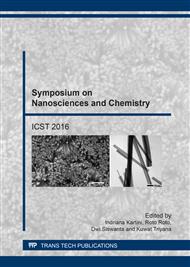[1]
N. Bhardwaj and S. C. Kundu, Electrospinning: A fascinating fiber fabrication technique, Biotechnol. Adv. 28 (2010) 325-347.
DOI: 10.1016/j.biotechadv.2010.01.004
Google Scholar
[2]
K. Garg and G. L. Bowlin, Electrospinning jets and nanofibrous structures, Biomicrofluidics 5 (2011) 1–19.
DOI: 10.1063/1.3567097
Google Scholar
[3]
M. Z. Elsabee, H. F. Naguib, and R. E. Morsi, Chitosan based nanofibers, review, Mater. Sci. Eng. C. 32 (2012) 1711–1726.
DOI: 10.1016/j.msec.2012.05.009
Google Scholar
[4]
Y. Jia, J. Gong, X. Gu, H. Kim, and J. Dong, Fabrication and characterization of poly(vinyl alcohol)/chitosan blend nanofibers produced by electrospinning method, Carbohyd. Polym. 67 (2007) 403-409.
DOI: 10.1016/j.carbpol.2006.06.010
Google Scholar
[5]
X. Mi, K. S. Vijayaragavan, and C. L. Heldt, Virus adsorption of water-stable quaternized chitosan nanofibers, Carbohydr. Res. 387 (2104) 24–29.
DOI: 10.1016/j.carres.2014.01.017
Google Scholar
[6]
R. Liu, X. Xu, X. Zhuang, and B. Cheng, Solution blowing of chitosan/PVA hydrogel nanofiber mats, Carbohyd. Polym. 101 (2014) 1116–1121.
DOI: 10.1016/j.carbpol.2013.10.056
Google Scholar
[7]
A. Esmaeili and A. A. Beni, A novel fixed-bed reactor design incorporating an electrospun PVA/chitosan nanofiber membrane, J. Hazard. Mater. 280 (2014) 788–796.
DOI: 10.1016/j.jhazmat.2014.08.048
Google Scholar
[8]
A. Razzaz, S. Ghorban, L. Hosayni, M. Irani, and M. Aliabadi, Chitosan nanofibers functionalized by TiO2 nanoparticles for the removal of heavy metal ions, J. Taiwan Inst. Chem. Eng. 58 (2016) 333-3435.
DOI: 10.1016/j.jtice.2015.06.003
Google Scholar
[9]
X. Qu, P. J. J. Alvarez, and Q. Li, Applications of nanotechnology in water and wastewater treatment, Water Res. 47 (2013) 3931–3946.
DOI: 10.1016/j.watres.2012.09.058
Google Scholar
[10]
R. Rošic, J. Pelipenko, J. Kristl, P. Kocbek, M. Bešter-Rogač, and S. Baumgartner, Physical characteristics of poly (vinyl alcohol) solutions in relation to electrospun nanofiber formation, Eur. Polym. J. 49 (2013) 290–298.
DOI: 10.1016/j.eurpolymj.2012.11.013
Google Scholar
[11]
S. N. Alhosseini, F. Moztarzadeh, M. Mozafari, S. Asgari, M. Dodel, A. Samadikuchaksaraei, S. Kargozar, and N. Jalali, Synthesis and characterization of electrospun polyvinyl alcohol nanofibrous scaffolds modified by blending with chitosan for neural tissue engineering, Int. J. Nanomedicine 7 (2012).
DOI: 10.2147/ijn.s25376
Google Scholar
[12]
E. A. El-hefian, M. M. Nasef, and A. H. Yahaya, The Preparation and Characterization of Chitosan/Poly(Vinyl Alcohol) Blended Films, J. Chem. 7 (2010) 1212-1219.
DOI: 10.1155/2010/626235
Google Scholar


